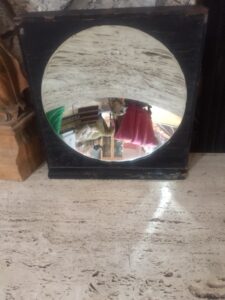 JR sent me a find from a shed in Victorville, a vintage glass parabolic concave mirror framed in a crude wood box at fourteen inch diameter. What did people use it for?
JR sent me a find from a shed in Victorville, a vintage glass parabolic concave mirror framed in a crude wood box at fourteen inch diameter. What did people use it for?
I’m no scientist, but research tells me a concave mirror collects light rays after it “sees” a reflection, and the image it sends back is “virtual” or inverted (upside down). Its brother, the convex mirror, seems ubiquitous. We use them in rear view mirrors, and the image takes a little getting used to, as cars behind look smaller and farther away. People close to my age hate those convex bathroom mirrors that magnify one’s face.
Experiment with a Teaspoon
A simple experiment with a teaspoon shows you the difference between concave and convex reflections. The interior bowl reflects as a concave mirror, and the exterior as a convex. You see a right side up image in the outer bowl, and an upside down image in the center bowl. Don’t ask me why: too much math.
The question remains what did they use the fourteen inch concave mirror for? Why did they put it in a wooden frame? The last question appears simple. We see the concave mirror thin at the center and wider at the edges, so they added frame later for protection. The later question I find harder. People used these mirrors throughout history in all sorts of optics, in philosophical metaphysics, and as a thing of beauty as well in interior lighting.
None other than Leonardo da Vinci drew plans in his Codex Atlanticus in 1503-1505 for machinery, called a Mirror Lapper, to make a concave mirror. He again returned to the problem in 1515, and made a model of the same in 1517 for the Science and Technology Museum in Milan.
Another Application for Concave Mirrors
William Parsons, a fan of da Vinci, in County Offaly, Ireland, in 1840 worked on the world’s largest reflecting telescope. At his Birr Castle, Demesne, a 400 year old manse, scientists came from all over (1845-1915) to discuss the “leviathan” that discovered the spiral nature of some galaxies.
Parsons, the Third Earl of Rosse, and his like-minded wife, Lady Mary, became early pioneer in the NEW medium called photography, which also used concave lenses. Meanwhile, their son Charles built a steam turbine out back. On family nights the three (early geeks) worked on the Lord’s massive telescope, and no doubt ate popcorn over a copy of da Vinci’s 1492 math studies of concave mirrors.
From Insanely Scientific to Mystical
In his 1617 book Ars Magna Lucis et Umbra Athanasius Kirchner illustrated in a beautiful woodcut of an alchemist at work. A concave mirror hermetically reflects the divine light in the eyes of the alchemist who then pours the light into the polis.
By the 18th century people used concave and convex mirrors for beauty and utility indoors, as they amplified candle power. It also showed you as rich enough to afford such a mirror. A series of etchings by John Gwynn (1713-1786) depicts the great concave mirror installed at Vauxhall Gardens on the South Bank of the Thames, in a grand rotunda.
Of course, every Early American 1950’s house where I grew up partook of the “Ethan Allen Colonial Style “ of home décor. We all owned a convex mirror, usually with a fake eagle on top. The real ones are quite valuable. I just appraised one for $20K.
Farther afield, the ancient practice of Feng Shui uses concave mirrors to receive and contain harmful energy in a room. Convex mirrors, called Bagua mirrors, are not “good Feng Shui” because they push the energy out, like a death ray.
What did they use JR’s mirror for?
Something destructive as well. This mirror was used for military purposes, probably from WWI, for a search light. The military used such mirrors in WWII as well, but they were usually Aluminum, not glass. I cannot put the mirror as earlier, because the “silver” is not “real” silver as in early mirrors, as I do not see the tell tale lichen-like spots associated with the degradation of the real silver back. But alas, JR’s mirror back is painted. War time mirrors usually shows some government branding on the reverse. The value is $400.